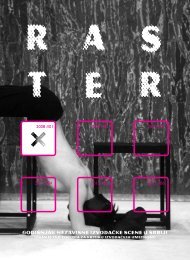Yearbook of the Independent Performing Arts Scene in Serbia - TkH
Yearbook of the Independent Performing Arts Scene in Serbia - TkH
Yearbook of the Independent Performing Arts Scene in Serbia - TkH
Create successful ePaper yourself
Turn your PDF publications into a flip-book with our unique Google optimized e-Paper software.
now!” activity, and nearly anonymous cultural practices <strong>of</strong> rallies, parades,amateur or folk dances etc. 10Now I would absta<strong>in</strong> from categorization and evaluation <strong>of</strong> <strong>the</strong>se bodilymovement forms <strong>in</strong> terms <strong>of</strong> artistic, aes<strong>the</strong>tic, and even political values, toconclude with someth<strong>in</strong>g that seems to me more central. Look<strong>in</strong>g throughthis lens I would op<strong>in</strong>e that dance as a cultural-artistic practice (and thisimplies contemporary dance as well), is not bodily practice <strong>of</strong> emancipationdisengaged from ideology, but a tool for shap<strong>in</strong>g <strong>the</strong> <strong>in</strong>dividual body as<strong>the</strong> social body. I propose this as a base for social conception <strong>of</strong> dance, aplatform from which we could and should start address<strong>in</strong>g qualitative differencesand particular purposes <strong>of</strong> this tool, as well as certa<strong>in</strong> <strong>in</strong>stancesand trials <strong>of</strong> resistance to <strong>the</strong> dom<strong>in</strong>ant ideology. This <strong>in</strong>itial standpo<strong>in</strong>t canalso help expla<strong>in</strong> <strong>the</strong> emergence <strong>of</strong> contemporary dance <strong>in</strong> <strong>the</strong> new postcommunistand socialist European countries, transform<strong>in</strong>g <strong>the</strong>ir ideologiesalong with <strong>the</strong> shift<strong>in</strong>g <strong>of</strong> <strong>the</strong>ir respective economic and political structurestoward capitalism and multi-party regimes.But, what’s it like <strong>in</strong> <strong>the</strong> ‘real life’? There is fierce criticism <strong>of</strong> <strong>the</strong> contemporarydance <strong>in</strong>fluences that come (or, ra<strong>the</strong>r, are be<strong>in</strong>g ‘imported’) from<strong>the</strong> West. How many times <strong>in</strong> recent years have I heard compla<strong>in</strong>ts bydance practitioners from Tall<strong>in</strong>n to Skopje that <strong>the</strong> only dance practiced <strong>in</strong><strong>the</strong> East, supported both locally and <strong>in</strong>ternationally, is choreography markedlyshaped by <strong>in</strong>fluences <strong>of</strong> <strong>the</strong> Western contemporary dance, conceptualdance <strong>in</strong> particular. On <strong>the</strong> o<strong>the</strong>r hand, Eastern choreographers who workalong <strong>the</strong> current l<strong>in</strong>es <strong>of</strong> contemporary European dance are used to be<strong>in</strong>glabeled by Western programmers and critics as lack<strong>in</strong>g anyth<strong>in</strong>g specificallyEastern and, accord<strong>in</strong>gly, with bad publicity <strong>of</strong> be<strong>in</strong>g constantly late(as opposed to <strong>the</strong>ir Western counterparts). 11 For <strong>in</strong>stance, I heard suchcompla<strong>in</strong>ts at <strong>the</strong> Mov<strong>in</strong>g Cake festival held <strong>in</strong> Ljubljana <strong>in</strong> 2005 and BITEFShowcase: Tel Quel <strong>in</strong> Belgrade <strong>in</strong> 2006. The unbearable ambiguity <strong>of</strong> thisposition is even rendered as <strong>the</strong> ma<strong>in</strong> concern <strong>of</strong> Saša Asentić’s piece IndigoDance (2007).10 Metaphorically speak<strong>in</strong>g, “a-pr<strong>of</strong>essional-Western-contemporary-dancer”is an ideal image <strong>of</strong> an <strong>in</strong>dependent, well-educated and accomplished manager <strong>of</strong>a private enterprise, while “an-Eastern-mass-<strong>of</strong>-(semi-)-amateur-performers” isa projection <strong>of</strong> a Workers’ Council where<strong>in</strong> each voice claims equal importanceand value <strong>in</strong> a workforce structure that belongs to all <strong>of</strong> <strong>the</strong>m (<strong>in</strong> fact, to <strong>the</strong>whole society).11 Statement by Bojana Kunst; see her text “<strong>Perform<strong>in</strong>g</strong> <strong>the</strong> O<strong>the</strong>r/EasternBody”, <strong>TkH</strong>, No 4, Belgrade, 2002. (Lecture, International Conference <strong>of</strong> TheBulgarian Theatre Association: Cultural Bridges, 4-5 June 2002, Varna, and FestivalTanztendenzen, June 12, 2002, Greifswald).







